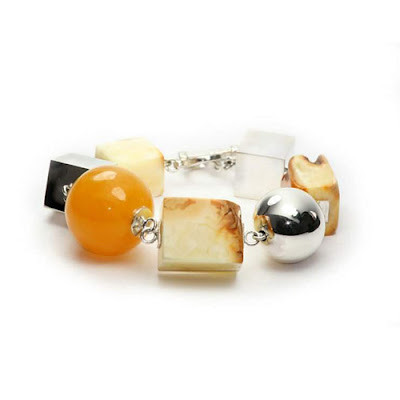When I was little, we used to collect colored stones, sea glass and amber on the shores of cold Baltic Sea. We would pile our treasures on the weathered timber of wave breakers extending far into the water, scrutinize, compare and trade the best pieces. Finding amber was easy then, especially the small, opaque, glass like pieces, rounded and tumbled for years through the sand. We would boast - if we were lucky, and found an insect trapped inside. These were rare pieces.
Amber can be found in many places on Earth, but the oldest, dated from 40-70 million years ago, comes from the Baltic Sea region, which contains 80% of world deposits. In ancient times it was highly valued and quickly became a trade commodity, travelling very far. Amber jewelry is believed to be produced since the Stone Age.
From pale yellow to dark orange brown, and often transparent, amber deserved its ancient greek name - electron - or "formed by the sun". It was believed to capture sun's warm and bright energy, have healing properties and to be restorative, calming and grounding. In Europe Baltic amber has been used for centuries to calm a teething baby, when worn close to the skin, due to high content of certain acid.
Amber is a happy, warm stone. Or rather, a fossilized resin. It was soon noticed it can hold some type of sparkly energy. A test for us children, to make sure we had a genuine piece of amber, was to rub it vigorously against a soft cloth, and use it to pick up some small paper pieces. Amber gets charged with static electricity. The pieces of paper would stick to it like to a magnet.
Some interesting facts about amber:
- it always feels warm in your hand
- it sinks in fresh water, but it is light enough to float in a salt solution
- it can be burned, emitting a sweet, musky, honey and pine like smell
- it can be melted or pulverized, and formed/pressed back into a shape (reconstituted amber)
- when cut with a knife, it breaks or splinters, unlike synthetic amber (resin), that can be clean cut or shaved
According to chemistry, amber is still alive, organic, breathing and interacting with its surroundings. Its transformation is not yet complete. Therefore it requires special care.
how to care about amber jewelry:
- keep away from sharp or rough objects - it is very soft
- when not worn, it should be kept away from direct sunlight, best in a pouch or a box
- it can be polished with soft cloth and a drop of olive oil, toothpaste, or silver polish
- do not use jewelry cleaning solutions or sonic cleaners
- avoid perfume, hairspray and chlorinated water - put your jewelry on last














Some interesting facts about amber are really interesting and useful. Recently, I have visited many blogs about this search but I have found all about amber in your post. Thanks and keep sharing.
ReplyDeleteThank you for kind comments! I really appreciate it and I'm happy you found the post useful.
ReplyDelete